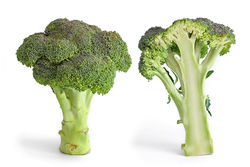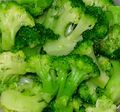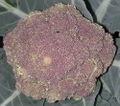Broccoli
| Broccoli |
|---|
 Broccoli, Calabrese cultivar |
| Species |
| Brassica oleracea |
| Cultivar group |
| Italica Group |
| Origin |
| From Italy (2,000 years ago)[1][2] |
Broccoli (from the Italian plural of broccolo, referring to "the flowering top of a cabbage")[3] is a plant of the mustard/cabbage family Brassicaceae (formerly Cruciferae). It is classified in the Italica cultivar group of the species Brassica oleracea. Broccoli has large flower heads, usually green in color, arranged in a tree-like fashion on branches sprouting from a thick, edible stalk. The mass of flower heads is surrounded by leaves. Many varieties of broccoli are perennial. Broccoli most closely resembles cauliflower, which is a different cultivar group of the same species.
Contents |
History
Broccoli evolved from a wild cabbage plant on the continent of Europe. Indications point to the vegetable's being known 2,000 years ago.[4] Since the Roman Empire, broccoli has been considered a uniquely valuable food among Italians.[5] Broccoli was first introduced to the United States by these immigrants, but did not become widely known until the 1920s.[4]
Uses
Culinary
Broccoli is usually boiled or steamed, but may be eaten raw and has become popular as a raw vegetable in hors d'œuvre trays. Boiling reduces the levels of suspected anti-cancer compounds in broccoli, with losses of 20 - 30% after five minutes, 40 - 50% after ten minutes, and 77% after thirty minutes.[6] However, other preparation methods such as steaming, microwaving, and stir frying had no significant effect on the compounds.[6] Steaming broccoli for 3-4 minutes is recommended to maximize the anti-cancer compound, sulforaphane.[7]
Nutritional and medicinal
| Nutritional value per 100 g (3.5 oz) | |
|---|---|
| Energy | 141 kJ (34 kcal) |
| Carbohydrates | 6.64 g |
| Sugars | 1.7 g |
| Dietary fibre | 2.6 g |
| Fat | 0.37 g |
| Protein | 2.82 g |
| Water | 89.30 g |
| Vitamin A equiv. | 31 μg (3%) |
| - beta-carotene | 361 μg (3%) |
| - lutein and zeaxanthin | 1121 μg |
| Thiamine (Vit. B1) | 0.071 mg (5%) |
| Riboflavin (Vit. B2) | 0.117 mg (8%) |
| Niacin (Vit. B3) | 0.639 mg (4%) |
| Pantothenic acid (B5) | 0.573 mg (11%) |
| Vitamin B6 | 0.175 mg (13%) |
| Folate (Vit. B9) | 63 μg (16%) |
| Vitamin C | 89.2 mg (149%) |
| Calcium | 47 mg (5%) |
| Iron | 0.73 mg (6%) |
| Magnesium | 21 mg (6%) |
| Phosphorus | 66 mg (9%) |
| Potassium | 316 mg (7%) |
| Zinc | 0.41 mg (4%) |
| Percentages are relative to US recommendations for adults. Source: USDA Nutrient database |
|
Broccoli is high in vitamins C, K, and A, as well as dietary fiber; it also contains multiple nutrients with potent anti-cancer properties, such as diindolylmethane and small amounts of selenium.[8] A single serving provides more than 30 mg of Vitamin C and a half-cup provides 52 mg of Vitamin C.[9] The 3,3'-Diindolylmethane found in broccoli is a potent modulator of the innate immune response system with anti-viral, anti-bacterial and anti-cancer activity.[10][11] Broccoli also contains the compound glucoraphanin, which can be processed into an anti-cancer compound sulforaphane, though the benefits of broccoli are greatly reduced if the vegetable is boiled.[6] Broccoli is also an excellent source of indole-3-carbinol, a chemical which boosts DNA repair in cells and appears to block the growth of cancer cells.[12][13] Broccoli has the highest levels of carotenoids in the brassica family.[14] It is particularly rich in lutein and also provides beta-carotene.[14]
A high intake of broccoli has been found to reduce the risk of aggressive prostate cancer.[15] Broccoli consumption has also been shown to be beneficial in the prevention of heart disease.[16]
Varieties
There are three commonly grown types of broccoli. The most familiar is a often referred to simply as "broccoli", and sometimes calabrese named after Calabria in Italy. It has large (10 to 20 cm) green heads and thick stalks. It is a cool season annual crop.
Sprouting broccoli has a larger number of heads with many thin stalks. It is planted in May to be harvested during the winter or early the following year in temperate climates. The heirloom variety "calabrese" available in North America is of this type.
Romanesco broccoli has a distinctive fractal appearance of its heads, and is yellow-green in colour. It is technically in the Botrytis (cauliflower) cultivar group.
Purple cauliflower is a type of broccoli sold in southern Italy, Spain, and the United Kingdom. It has a head shaped like cauliflower, but consisting of tiny flower buds. It sometimes, but not always, has a purple cast to the tips of the flower buds.
Other cultivar groups of Brassica oleracea include cabbage (Capitata Group), cauliflower (Botrytis Group), kale and collard greens (Acephala Group), kohlrabi (Gongylodes Group), and Brussels sprouts (Gemmifera Group). Chinese broccoli (Alboglabra Group) is also a cultivar group of Brassica oleracea.[17]
Production
In North America, production is primarily in California. The seasonal average f.o.b. shipping-point price for cauliflower in 2004 was $33.00 per 100 pounds ($0.73/kg) according to the National Agricultural Statistics Service, USDA.
| Top ten cauliflowers and broccoli producers—11 June 2008 | ||
|---|---|---|
| Country | Production (tonnes) | Footnote |
| 8,585,000 | F | |
| 5,014,500 | ||
| 1,240,710 | ||
| 450,100 | ||
| 433,252 | ||
| 370,000 | F | |
| 305,000 | F | |
| 277,200 | ||
| 209,000 | F | |
| 186,400 | ||
| World | 19,107,751 | A |
| No symbol = official figure, F = FAO estimate, * = Unofficial/Semi-official/mirror data, C = Calculated figure A = Aggregate (may include official, semi-official or estimates); |
||
Cultivation
Broccoli is a cool-weather crop that does poorly in hot summer weather. Broccoli grows best when exposed to an average daily temperature between 18 and 23 degree Celsius (64 and 73 °F).[18] When the cluster of flowers, also referred to as a "head" of broccoli, appear in the center of the plant, the cluster is green. The cluster will appear exactly like the broccoli you eat every so often. You need to use garden pruners or sheers to cut the head about an inch from the tip, and be sure that you cultivate it before the flowers on the head bloom bright yellow.[19]
Gallery
|
Extreme close-up of broccoli florets. |
 Broccoli flowers. |
 Two broccoli heads. |
 Romanesco broccoli, showing fractal forms |
 Steamed broccoli |
 Sicilian Purple Broccoli |
 Broccoli in flower |
 Two broccoli heads. |
 A leaf of a Broccoli plant |
 Several Broccoli plants growing in Melbourne, Australia and ready for harvest |
References
- ↑ Buck, P. A. "Origin and Taxonomy of Broccoli". Department of Food Technology, University of California. http://www.springerlink.com/content/ert85x3082740212/fulltext.pdf. Retrieved 2009-05-14.
- ↑ Stephens, James. "Broccoli—Brassica oleracea L. (Italica group)". University of Florida. p. 1. http://edis.ifas.ufl.edu/MV031. Retrieved 2009-05-14.
- ↑ "broccoli". Merriam-Webster's Collegiate Dictionary (11th ed.). p. 156. ISBN 9780877798095. http://www.merriam-webster.com/dictionary/broccoli. Retrieved 24 August 2009.
- ↑ 4.0 4.1 Murray, Michael; Lara Pizzorno (September 2005). The Encyclopedia of Healing Foods. Simon & Schuster Adult Publishing Group. p. 172. ISBN 9780743480529. http://books.google.com/?id=LLFLfbiWpqgC&pg=PA172&dq=History+of+broccoli#v=onepage&q=History%20of%20broccoli.
- ↑ Nonnecke, Ib (November 1989). Vegetable Production. Springer-Verlag New York, LLC. p. 394. ISBN 9780442267216. http://books.google.com/?id=H7i8QJw8BJsC&pg=PA394&dq=History+of+broccoli#v=onepage&q=History%20of%20broccoli.
- ↑ 6.0 6.1 6.2 Warwick Medical School, University of Warwick (2007-05-15). "Research Says Boiling Broccoli Ruins Its Anti Cancer Properties.". http://www2.warwick.ac.uk/newsandevents/pressreleases/research_says_boiling/.
- ↑ "Maximizing The Anti-Cancer Power Of Broccoli". Science Daily. 2005-04-05. http://www.sciencedaily.com/releases/2005/03/050326114810.htm.
- ↑ "WHFoods: Broccoli". George Mateljan Foundation. http://www.whfoods.com/genpage.php?tname=foodspice&dbid=9. Retrieved 2009-05-11.
- ↑ Understanding Nutrition, Eleanor N. Whitney and Eva M. N. Hamilton, Table H, supplement, page 373 Table 1, ISBN 0-8299-0419-0
- ↑ "Diindolylmethane Information Resource Center at the University of California, Berkeley". http://www.diindolylmethane.org. Retrieved 2007-06-10.
- ↑ "Diindolylmethane Immune Activation Data Center". http://www.activamune.com/diindolylmethane_dim_immune_activation_data_center.htm. Retrieved 2007-06-10.
- ↑ "Broccoli chemical's cancer check". BBC News. 7 February 2006. http://news.bbc.co.uk/2/hi/health/4688854.stm. Retrieved 5 September 2010.
- ↑ "How Dietary Supplement May Block Cancer Cells". Science Daily. 30 June 2010. http://www.sciencedaily.com/releases/2010/06/100629131316.htm. Retrieved 5 September 2010.
- ↑ 14.0 14.1 "Breeding Better Broccoli: Research Points To Pumped Up Lutein Levels In Broccoli". Science Daily. 8 November 2009. http://www.sciencedaily.com/releases/2009/11/091104132824.htm. Retrieved 5 September 2010.
- ↑ Kirsh, VA; Peters U, Mayne ST, Subar AF, Chatterjee N, Johnson CC, Hayes RB (2007). "Prospective study of fruit and vegetable intake and risk of prostate cancer". Journal of the National Cancer Institute 99 (15): 1200–9. doi:10.1093/jnci/djm065. PMID 17652276.
- ↑ Clout, Laura (5 September 2009). "Broccoli beats heart disease". Daily Express. http://www.express.co.uk/posts/view/125136/Broccoli-beats-heart-disease. Retrieved 5 September 2009.
- ↑ Dixon, G.R. (2007). Vegetable brassicas and related crucifers. Wallingford: CABI. ISBN 9780851993959.
- ↑ Smith, Powell (June 1999). "HGIC 1301 Broccoli". Clemson University. http://www.clemson.edu/extension/hgic/plants/vegetables/crops/hgic1301.html. Retrieved 25 August 2009.
- ↑ Liptay, Albert (1988). "Broccoli". Broccoli. World Book, Inc..
External links
- PROTAbase on Brassica oleracea (cauliflower and broccoli)
- Broccoli, Nutritional Values and Best Consuming Ways
- List of North American broccoli cultivars, USDA/ARS Vegetable Laboratory
- Broccoli Macro, Closeup view of broccoli
- [1], Vegetarians in Paradise; Broccoli: The Crown Jewel of Nutrition
|
|||||